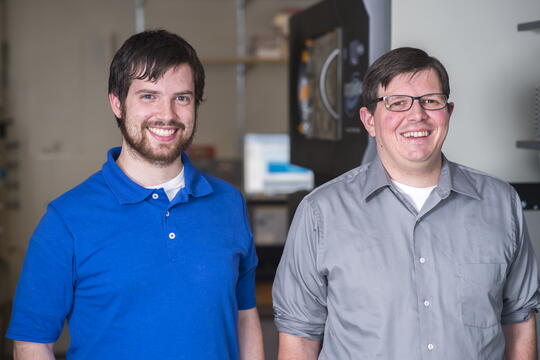
Staphylococcus aureus is an antibiotic-resistant pathogen labelled as a “serious threat to human health” by the World Health Organization and the Centers for Disease Control. This bacteria is also the subject of a recent paper published by the laboratory of Dr. Thomas Kehl-Fie, Assistant Professor in the Department of Microbiology, in the Journal of Bacteriology, titled “Intracellular accumulation of staphylopine can sensitize S. aureus to host-imposed zinc starvation by chelation-independent toxicity.” With graduate student Kyle Grim as first author, the paper describes a surprising conclusion made while investigating how S. aureus causes infection.
Through a defense known as “nutritional immunity,” infected hosts limit pathogens’ access to zinc (and other essential metals like iron or manganese) within their bodies in an attempt to “starve” their invaders and weaken infection. Kehl-Fie explained that zinc starvation works because “zinc is a critical structural metal that enables the folding and activity of proteins in bacteria and all other forms of life. It is estimated that around 6-10% of bacterial proteins use zinc as either a structural or catalytic cofactor, while about 50% of all enzymes use a metal as a cofactor.” This means that every time protein activity is required, there’s a “one-in-two chance” that a metal will be used to help facilitate the protein’s activity.
To overcome this barrier to infection, pathogens like S. aureus secrete small metal-loving molecules called metallophores into their environments to “fish” for the metals they need. (Metallophores that fish for zinc are zincophores, ones that look for iron are siderophores, and so on.) Once metallophores find their metal of interest, they bind to the metal to form complexes that re-enter the cell to deliver their catch.
Normally, zincophores (called staphylopine in S. aureus) help bacterial cells stave off metal starvation when they are produced in regular quantities and exit the cell to return with zinc; however, the Kehl-Fie lab noticed that when the number of zincophores inside S. aureus cells accumulates past a typical threshold, the cells suffer.

For example, Kehl-Fie explained that the lab “eliminated the ability of S. aureus to make staphylopine efflux pumps and that those mutants became functionally avirulent (suffered a profound loss in their ability to cause disease). We knew accumulation of staphylopine was bad for the bacteria, but we didn’t realize how bad. To put it in perspective, if you eliminate all the mechanisms that S. aureus has for obtaining zinc, the loss of their ability to secrete staphylopine into the environment (and empty the cell of them) is just as bad as that.”
“The initial hypothesis that was floated by the field and which made sense on a first-principle basis is that staphylopine binds zinc really tightly, and thus when trapped in the cell, it prevents zinc from getting to the proteins that need zinc to function,” Kehl-Fie said.
However, the lab’s findings suggest that this model may be wrong. Metal-starved cells usually take in metals through metal transporters embedded in their cellular membranes. “If staphylopine accumulates within S. aureus cells and metal starves them, you’d assume that the cells would turn on their metal transporters,” Kehl-Fie said. “S. aureus doesn’t do that.”
That behavior led to the lab’s final observation, made using a technique that allows a direct assessment of the quantities of metal accumulated in the cell: they found that S. aureus doesn’t gather more metals when staphylopine is trapped within cell walls.
“I think that the primary conclusion one can draw from this work is that the toxicity is not driven by metal starvation. It wasn’t our goal when we set out to challenge the accepted model, so this was surprising. We also weren’t expecting the virulence defect to be as pronounced as it was in the strain lacking the efflux pump,” Kehl-Fie said.
The lab also believes their results with staphylopine in S. aureus could be extended to the zincophore in the pathogen Pseudomonas aeruginosa (called pseudopaline) and perhaps even to the ones in other bacteria. If so, these results make this research topic widely relevant towards the race to produce new antibiotics for treating infection.
This paper was published in collaboration with Prof. Christopher Devitt’s lab from the Peter Doherty Institute for Infection and Immunity at the University of Melbourne in Melbourne, Australia.